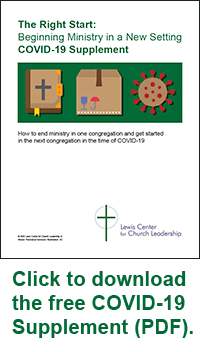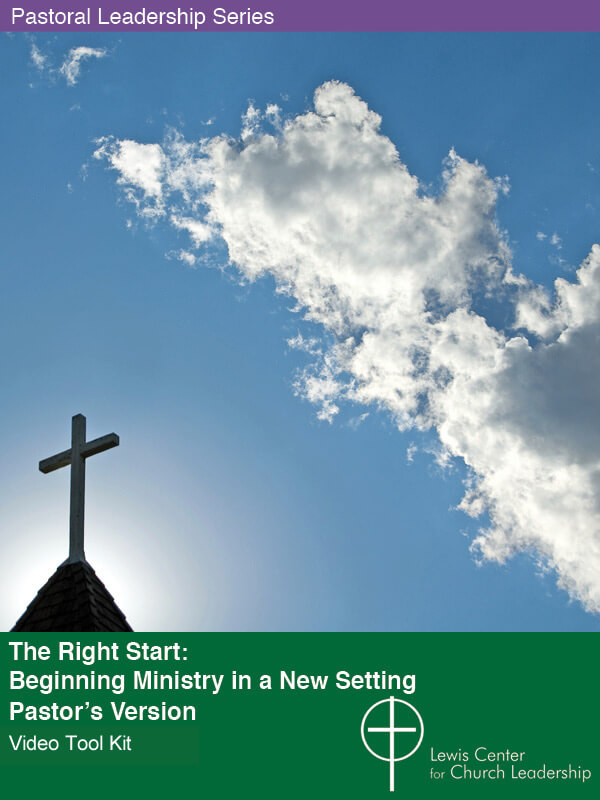The Right Start in the Era of COVID-19
 The arrival of a new pastor is a critical juncture in the life of a church. A pastor’s successful transition lays the groundwork for a fruitful tenure. The Lewis Center has helped many pastors navigate this important time of transition with resources to plan a smooth departure from one ministry setting and an effective entry into the next.
The arrival of a new pastor is a critical juncture in the life of a church. A pastor’s successful transition lays the groundwork for a fruitful tenure. The Lewis Center has helped many pastors navigate this important time of transition with resources to plan a smooth departure from one ministry setting and an effective entry into the next.
The COVID-19 crisis raises many questions about how to transition from one congregation to the next because of the unusual circumstances it creates. Many congregants are sheltering in place, many churches have suspended in-person worship, and normal patterns of engagement and activities are disrupted.
In late April 2020, the Lewis Center surveyed a trusted group of pastoral leaders and judicatory leaders to gather their ideas and thoughts about making a successful transition in this challenging time. Their recommendations are summarized in this document.
The challenges of the day demand creativity and flexibility. We hope these ideas will help pastors and congregations meet the moment with hope and confidence. But even in this unusual time, the fundamental practices that make for a good transition are still relevant. Indeed, they are more important than ever. So, these suggestions are offered as an addendum to the time-tested advice in The Right Start: Beginning Ministry in a New Setting.
Lovett H. Weems, Jr.
“The Right Start: Beginning Ministry in a New Setting” Video Tool Kit
>>> The Right Start: Pastor’s Version download is $25 for a limited time — save nearly 60 percent.
If you’re a pastor preparing to begin ministry in a new setting, The Right Start leads you in ending your current ministry well, developing a personal transition plan, and making the most of your first days, weeks, and months in your new congregation. Available in Pastor’s and Group Training Versions on download and DVD/CD.
Learn more and watch a video preview at churchleadership.com/therightstart.
1. Leaving Well
For pastors, the first step in an effective transition is drawing to a close the ministry in the church they are leaving. Pastors give attention to this not for their own sake but for the benefit of the congregation and their successor. Achieving a proper sense of closure is beneficial for the exiting pastor, the incoming pastor, and the congregation. Current circumstances require some adjustment to the usual patterns of saying farewell and preparing your successor. Here are some suggestions:
Saying goodbye
Saying goodbye to church members, leaders, and others in the congregation you are exiting is a critical step in preparing to leave. The purpose of these farewells is to give thanks, ask pardon where needed, offer prayers, extend God’s blessings, and show support for your successor. In these days of COVID-19, it is important to follow the same protocols for saying goodbye to church and community leaders. But the conversations may need to happen in a different way. Here are some possibilities:
- Make lots of phone calls.
- Meet with people for coffee or lunch over Zoom.
- Host several Zoom opportunities where members sign up for conversations in small groups.
- Send a pastoral letter.
- Upload a video farewell message to the congregation and send a link to members.
Farewell celebrations/closing worship service
Rituals are an important aspect of transition. So, it’s important to mark a pastor’s departure in ways that are appropriate to the current situation. Here are some options to consider:
Postpone the farewell
- If the incoming pastor approves, schedule an event for the outgoing pastor at a later time.
Plan a virtual farewell
- Plan a service on Zoom using the “Order of Farewell to a Pastor” from the Book of Worship.
- Prepare and share a video or slide show of highlights from the pastor’s tenure.
- Host a Zoom party with the congregation.
Plan creative, live experiences that maintain proper social distancing.
- In some jurisdictions, holding a final worship service in the church building may be possible if local safety protocols are followed. This may require multiple in-person services with a limited number of participants at each.
- A fellowship event might be possible with rotating groups of ten with proper distancing by families or individuals, especially if it is held outdoors.
- Plan a drive-in parking lot farewell ceremony, a drive–by salute with waves and signs, or a parade.
Invite the congregation to say goodbye and express appreciation.
- Encourage people to call the pastor or write personal notes of love and gratitude.
- Orchestrate a “Card Shower” by gathering written messages, isolating them for a few days, and delivering them en masse.
- Assemble a scrapbook with pictures and notes or a collage of pictures that are meaningful to the pastor.
- Submit a story in the local newspaper.
- You can still do a love offering!
Attend to the emotional dimensions of transition.
COVID-19 adds layers of complexity to an already emotional time. The sense of grief and loss that accompanies transition will be heightened for everyone. Emotions may manifest themselves in a variety of ways, some negative. In this challenging time, it is especially important to:
- Communicate generously and bring comfort and hope.
- Stay strong yourself to be able to help others.
- Rely on the support of colleagues and confidants.
- Find outlets for your own anxiety and worries.
- Find time, even if only a day or a few days, to take a “transitional Sabbath” for your own well-being
Pave the way for your successor.
As always, it is important to express support for the incoming pastor and ask members to embrace their new pastor.
- Encourage virtual meetings of church leadership with the new pastor.
- If the arriving pastor has services online, encourage members to view them as a way to begin getting to know the new pastor.
2. Parsonages, Offices, and Moving
Pastors and congregations understand the importance of having clean space ready for a new pastor’s arrival. Experience has taught that people’s understanding of “clean” varies considerably! However, this year the preparation of a pastor’s office or living space is no laughing matter. It is deadly serious.
Familiarizing the incoming pastor (and family) with the parsonage and office space
- Physical visits to view the parsonage and office prior to moving may be impossible or more limited than in the past.
- As an alternative, prepare a virtual tour by video, a collection of photos, and floor plans with measurements.
Repairs
- Keep repairs to a minimum this year. Time and attention need to go elsewhere unless there are things that must be done right away.
- Maintain a list of repairs that should be undertaken when circumstances change, such as painting.
Where there is no parsonage
- Remember that an incoming pastor may have more difficulty selling their previous home and/or finding a new one to purchase. Alternative housing options may be necessary in the interim.
- Retired clergy and lay speakers could fill in if difficulty securing housing delays the arrival of an incoming pastor.
Clean and sanitize the pastor’s office and parsonage.
- Whether the cleaning and sanitizing is done by a professional service or volunteers, follow the procedures regarding COVID-19 on the CDC website: “Reopening Guidance for Cleaning and Disinfecting Public Spaces, Workplaces, Businesses, Schools, and Homes.”
- Leave some documentation, even a handwritten note, indicating when the cleaning and sanitizing took place and that CDC guidelines were followed. People are anxious and assurance is appreciated.
Consider leaving the parsonage empty for a period of time.
- It may be beneficial to allow a buffer of time between the departing pastor’s move out of the parsonage and the new pastor’s arrival.
- Ask the incoming pastor if this gap would be helpful. If so, make provisions for alternate housing in the interim and delay delivery by movers.
- While the parsonage is vacant, seal it off. Strict protocols are needed so people are not randomly entering, for example to bring welcoming items.
- If a previous resident had COVID-19, the parsonage may need to be unoccupied for a longer time.
Movers
- Ask any professional movers what guidelines they follow regarding sanitizing and wearing protective gear.
- Limit the use of volunteer helpers to those who are healthy and can be equipped with sufficient protective gear. The use of any volunteers on the arrival day should be cleared with the incoming pastor.
Welcome to the Parsonage
- Ask the incoming occupants what welcome activities would feel comfortable to them.
- Perhaps children and youth could prepare welcome signs and place them in the yard.
3. Entering a New Congregation and Getting Acquainted
One key to a smooth arrival in a new church is spending as much time as possible getting to know members and learning as much as possible about the church, the community, and the people. This listening and learning often happens in face-to-face meetings, social events, or house parties. But some of these early visitation practices will need to be replaced by other forms of communication. Here are some possibilities.
Use all available methods of communication to get acquainted with church members and let them get acquainted with you.
- It is best practice under normal circumstances for a pastor to make phone calls their very first day to key members and leaders. These contacts are more important now than ever.
- Prepare a video introduction of yourself (and family if applicable). Post it to the church website or send the link to congregants. Invite the congregation to send you video introductions of themselves.
- Use Zoom or another online meeting platform for meetings with key leaders and committees and for small gatherings with individuals or families.
- Write personal notes to people you can’t meet in person or online.
- Other forms of written communication – an introductory letter to the congregation, a column in the newsletter – will carry more weight than usual in this time of limited face-to-face contact.
- Consider using online polls or surveys to learn about people and their ideas.
- Ask for a photo directory if available.
Plan creative live gatherings that maintain appropriate social distancing when appropriate.
- As pandemic policies are relaxed, it may be possible to organize small gatherings of 10 people or fewer following safety protocols. You may choose to use the fellowship hall with a different table for each family unit spaced appropriately apart, or host lawn chair gatherings of 10 or fewer with appropriate social distancing.
- Be sensitive to the fact that many people will be wary of personal interaction for some time no matter how regulations change.
- Make drive–by visits of peoples’ homes. Tell them when you are coming by and that you are praying for them.
Attend to the emotional dimensions of the entry of a new pastor.
- Because our lives are in a state of flux, many things you need or want to accomplish will take extra care and extra time. Be patient with people, systems, and processes.
- People may be experiencing displaced grief, especially if they did not have the opportunity to say a proper goodbye to the former pastor. Many people will be in recovery, still processing the displacement, so be sensitive and listen.
- Be gentle with yourself, take regular time off, and practice self-care.
4. Preaching and Worship in the First Months
In a time when many congregations are not worshiping in their buildings, stepping into the “pulpit” for the first time comes with a whole new set of challenges. Depending on your location you may need to begin worshipping online, so be prepared!
Planning and preparations
- Be in touch with the outgoing pastor to review the current worship style, format, protocols, and resources.
- If the congregation is offering online worship, view the services to get a sense of how things are happening.
- Inquire in advance about what technology is available. Use whatever video/virtual platform was used before transition.
- Connect with the worship team and worship leaders well in advance of your first Sunday to get familiar with new procedures.
- Work closely with the those responsible for putting together online worship. Consider asking them to prepare worship for the first few Sundays as they have been, leaving a spot for the new pastor’s sermon.
- Plan ahead and give plenty of lead time to others preparing their contributions to the service.
- Be prepared with contingency plans for several scenarios.
Messaging
An incoming pastor’s early sermons are an important way for the congregation to become familiar with their new pastor — especially in this time of limited face-to-face interaction.
- Use the first several sermons to introduce yourself, share your autobiography, your call to ministry, and personal testimony while also setting the stage for mutual ministry.
- Personal and informal styles of preaching online can connect well.
- The collective narrative about the experience of COVID-19 cannot be ignored.
- Speak hopefully about the future. Preach trust, faith, and the importance of caring for people and community.
- As you begin to learn about the community and its concerns, you can preach to their felt needs and spiritual hungers.
- Concentrate in the first months on building trust.
Respect what is familiar and build on it.
It is commonly advised that incoming pastors become fully acquainted with a congregation’s worship practices before making any changes. Remember, congregations have already experienced seismic shifts to their worship due to COVID-19 restrictions, and more change is coming. So, it is even more important to be sensitive to the congregation’s ability to absorb change.
- Find out what the church is currently doing and be prepared to start with that. If the church is worshiping online, continue the same way of doing online worship.
- Stick with familiar music, hymns, and other liturgical resources.
- Don’t insist on a new way based on your preferences or opinions.
- Make changes gradually, with lots of consultation.
5. Congregational and Community Financial Stress
Coming to understand a church’s financial picture is always a priority for an incoming pastor. The COVID-19 era makes the subject more urgent. There is little time to waste and the stakes could be quite high. Churches are in different positions regarding their financial heath and stability after so long a time without in-person worship. Here are some suggestions:
Gather information
It is critical to learn all you can as quickly as you can. Don’t assume the new situation is like that of your former church.
Learn about the church’s overall financial status
- Connect as soon as possible with the outgoing pastor, financial leaders, and staff to gather information about the church’s finances.
- Ask about recent financial history before COVID-19. Become familiar with all funds and sources of revenue. Does the church have cash reserves, a capital reserve, or endowment?
- Ask about actions taken in response to the COVID-19 crisis. Has there been any borrowing? Any grants? What actions have been taken regarding income or expenses?
- Ask for specific data on changes year to date and changes that have occurred since COVID-19.
- Ask finance leaders how they weathered the 2008 recession.
- Talk with pastors of other churches in the area to compare notes.
What is the situation regarding giving?
- Learn the trends in giving before and during COVID-19.
- Ask how giving has been encouraged since in-church worship ended? Has the church increased the available ways of giving during the pandemic?
- Identify what has not been tried based on what you know from the experience of other churches.
What is the situation regarding staffing or staff changes?
- Be in conversation regularly with finance and personnel committees about any anticipated reductions in staffing.
- If staff have been let go, the new pastor needs detailed information, including any promises for rehiring or other commitments.
Know that clear communication and sensitive leadership are required in this time of crisis.
Demonstrate concern for members and community.
- Discover how the COVID-19 stay–at–home orders have impacted church members and the larger community.
- Be sensitive to potential for hurt and financial distress even when not openly shared.
- Ask what the church is doing to address needs and what is planned for the future.
- Make sure the church’s financial stress does not supersede concern for the financial stress of members and neighbors.
Lead in a manner that meets the moment.
- Practice transparency and encourage others to do so as well.
- Affirm whatever the church has done to continue ministry under difficult circumstances. Work with their existing plan and then build upon it.
- Be prepared to educate the congregation about their financial situation. Interpret what you have learned from leaders and data in ways that speak to the church’s challenges.
- Always remind people of the church’s commitment to its mission. Discipling and missional engagement are needed now more than ever. Remind people that the building may be closed but the ministry continues.





